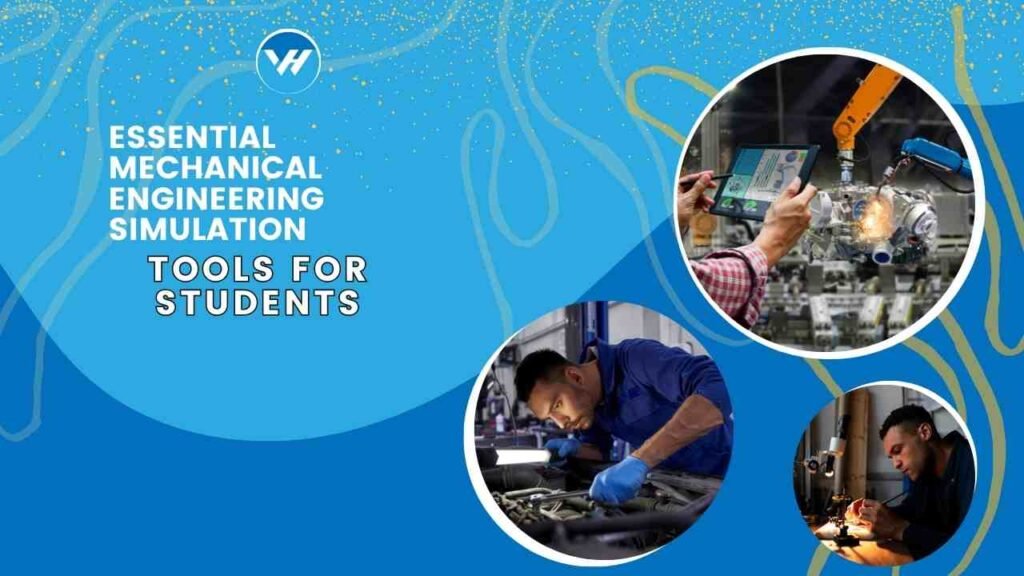In the dynamic world of mechanical engineering, simulation tools have become indispensable for both students and professionals. These digital tools allow for the virtual modeling, analysis, and optimization of mechanical designs, which is crucial in understanding and solving complex engineering problems. For students, mastering these tools is not just an academic exercise; it’s a critical step toward becoming competent engineers who can contribute to real-world projects. In this article, we’ll explore the essential mechanical engineering simulation tools that every student should be familiar with, delve into their applications, and discuss how platforms like Virtual Help can assist in mastering these tools.

Table of Contents
ToggleUnderstanding Mechanical Engineering Simulations
What Are Mechanical Engineering Simulations?
Mechanical engineering simulations involve using sophisticated software to create virtual models of physical systems. These models can simulate a variety of conditions, such as mechanical stresses, fluid dynamics, and thermal effects, to predict how the system will behave in the real world. The primary purpose of these simulations is to analyze and optimize designs before physical prototypes are created, saving both time and resources. For students, these simulations offer a hands-on approach to learning complex concepts and applying theoretical knowledge to practical problems.
Types of Mechanical Engineering Simulations
Mechanical engineering simulations encompass a wide range of analyses, each focusing on different aspects of mechanical systems. The most common types include:
- Finite Element Analysis (FEA): Used for analyzing the structural integrity of components and systems by breaking down complex structures into smaller elements.
- Computational Fluid Dynamics (CFD): Focuses on the behavior of fluids (liquids and gases) within and around objects, particularly in terms of flow and heat transfer.
- Multibody Dynamics (MBD): Examines the interactions between interconnected rigid or flexible bodies under various forces and moments.
Each of these simulation types has its own set of specialized tools and software, which we’ll explore in the following sections.
Key Simulation Tools for Mechanical Engineering Students
Finite Element Analysis (FEA) Tools
Overview of FEA
Finite Element Analysis (FEA) is a cornerstone of mechanical engineering simulations. It involves breaking down complex geometries into smaller, simpler parts called elements. These elements are connected at points known as nodes, creating a mesh. The FEA software then uses mathematical equations to simulate the behavior of each element under various conditions, such as stress, strain, and thermal effects. This method allows engineers to predict how a product will react to real-world forces, identify potential failure points, and optimize designs for better performance.
Popular FEA Software
- ANSYS: ANSYS is one of the most widely used FEA tools in both academia and industry. It offers a comprehensive suite of simulation tools that cover structural analysis, thermal analysis, and more. ANSYS is known for its high accuracy and ability to handle complex simulations, making it a go-to tool for detailed engineering analysis.
- SolidWorks Simulation: Integrated with the SolidWorks CAD software, SolidWorks Simulation provides an accessible option for students. It’s particularly user-friendly, making it ideal for those new to FEA. SolidWorks Simulation offers features like static, dynamic, and thermal analysis, helping students understand the mechanical behavior of their designs.
- ABAQUS: ABAQUS, developed by Dassault Systèmes, is known for its advanced capabilities in handling complex simulations, such as those involving nonlinear materials and large deformations. It’s widely used in research and development for solving sophisticated engineering problems.
Computational Fluid Dynamics (CFD) Tools
Introduction to CFD
Computational Fluid Dynamics (CFD) is another critical area of mechanical engineering simulations. CFD tools simulate the behavior of fluids—liquids and gases—within and around objects. These simulations are essential for understanding phenomena such as airflow over an airplane wing, heat transfer in a cooling system, or fluid flow through a pipeline. CFD simulations help engineers optimize designs to improve efficiency, reduce energy consumption, and enhance performance.
Leading CFD Software
- ANSYS Fluent: ANSYS Fluent is a powerful CFD tool that offers detailed insights into fluid dynamics and heat transfer processes. It’s capable of handling a wide range of fluid flow problems, from simple laminar flows to complex turbulent and multiphase flows. ANSYS Fluent is known for its accuracy and robustness, making it a preferred choice for both academic research and industrial applications.
- OpenFOAM: OpenFOAM is an open-source CFD software that offers extensive customization options. It’s widely used in academia and research due to its flexibility and cost-effectiveness. OpenFOAM supports a wide range of simulations, including heat transfer, chemical reactions, and multiphase flows. Its open-source nature allows students to modify the code to suit specific needs, making it a valuable tool for advanced learning.
- COMSOL Multiphysics: COMSOL is renowned for its multiphysics capabilities, allowing users to couple CFD with other types of simulations, such as structural and thermal analysis. This makes COMSOL a versatile tool for studying complex interactions between different physical phenomena. Its user-friendly interface and extensive library of predefined physics make it accessible for students.
Multibody Dynamics (MBD) Tools
What is MBD?
Multibody Dynamics (MBD) involves the study of systems composed of multiple interconnected bodies that can move relative to each other. These bodies can be rigid or flexible, and their interactions under various forces and moments are of primary interest. MBD simulations are essential for understanding the dynamics of complex mechanical systems, such as vehicles, machinery, and robotic systems. By analyzing these interactions, engineers can predict how systems will behave in motion, optimize their performance, and ensure their stability.
Notable MBD Software
- MSC Adams: MSC Adams is one of the most widely used MBD tools for simulating mechanical systems. It allows engineers to study the motion of systems with multiple interacting parts, such as suspension systems in vehicles or robotic arms in manufacturing. Adams offers powerful features for simulating kinematics, dynamics, and control systems, making it an essential tool for both education and industry.
- Simpack: Simpack is another leading MBD tool, particularly known for its high-performance simulations in the automotive and railway industries. It provides detailed analyses of mechanical systems, allowing engineers to optimize designs for stability, comfort, and efficiency. Simpack’s advanced solver technology ensures accurate and fast simulations, making it suitable for both academic and professional use.
- RecurDyn: RecurDyn is recognized for its versatility in simulating complex mechanical systems with both rigid and flexible bodies. It’s particularly useful for simulating systems with significant deformation, such as flexible shafts or belts. RecurDyn’s integrated environment allows for the coupling of MBD with FEA, providing a comprehensive solution for analyzing mechanical systems.
Choosing the Right Simulation Tool
Factors to Consider When Selecting Simulation Software
When choosing a simulation tool, several factors should be considered to ensure it meets your needs:
- Accuracy: The tool’s ability to produce results that closely match real-world behavior is crucial. Accurate simulations lead to better-informed decisions and more reliable designs.
- Usability: The software should be user-friendly, especially for students who are new to simulation tools. A steep learning curve can be a barrier to effective learning and application.
- Integration: Consider how well the simulation tool integrates with other software you’re using, such as CAD programs or other analysis tools. Smooth integration can save time and reduce the potential for errors.
- Support and Community: A tool with a strong support network, including tutorials, forums, and customer service, can be invaluable. An active user community can also provide additional resources and insights.
Budget and Accessibility
Simulation tools can range from expensive commercial software to free, open-source options. As a student, it’s important to consider your budget and look for tools that offer educational licenses or discounts. Many leading software companies provide student versions with limited features but enough capability for educational purposes. Open-source software like OpenFOAM is also a great option for those who need powerful tools without the cost.
Benefits of Using Simulation Tools
Enhancing Problem-Solving Skills
One of the greatest benefits of using simulation tools is the enhancement of problem-solving skills. By simulating real-world scenarios, students can experiment with different approaches to solving engineering problems. This hands-on experience is invaluable for developing critical thinking and creativity, both of which are essential for success in engineering.
Improving Design Accuracy
Simulation tools allow students to identify potential design flaws early in the process, reducing the risk of costly errors later on. By refining designs based on simulation results, students can create more accurate and reliable products. This ability to iterate and improve designs is a key skill that will serve students well in their future careers.
How to Get Started with Simulation Tools
Basic Steps to Begin Using Simulation Software
- Choose Your Software: Start by selecting a simulation tool that fits your needs and budget. Consider the type of simulations you’ll be performing and whether the tool offers the necessary features.
- Learn the Basics: Familiarize yourself with the software by going through tutorials, reading the documentation, and exploring online resources. Understanding the fundamental concepts and operations is crucial for effective use.
- Apply Your Knowledge: Begin with simple projects to build your confidence and skills. As you become more comfortable with the software, gradually move on to more complex simulations.
- Seek Feedback: Use resources like online forums, academic support, and professional communities to seek feedback on your work. This can provide valuable insights and help you improve your simulation techniques.
Leveraging Virtual Help for Mastering Simulation Tools
Virtual Help offers an excellent platform for students looking to master mechanical engineering simulation tools. With access to expert tutors, students can receive personalized guidance and support in learning how to use these tools effectively. Whether you’re struggling with a specific simulation or need help understanding a complex concept, Virtual Help can connect you with professionals who have real-world experience in using these tools. Additionally, the platform provides a range of resources, from tutorials to assignment assistance, making it easier for students to achieve their academic goals.
Conclusion
Mechanical engineering simulation tools are essential for students aiming to excel in their field. By mastering tools like ANSYS, SolidWorks Simulation, and OpenFOAM, students can enhance their problem-solving skills, improve design accuracy, and gain valuable hands-on experience. With the support of platforms like Virtual Help, students can overcome challenges and build the expertise needed to succeed in the competitive world of mechanical engineering. As technology continues to advance, proficiency in these tools will become increasingly important, making them a vital part of any mechanical engineering education.
FAQs
1. What is the difference between Finite Element Analysis (FEA) and Computational Fluid Dynamics (CFD)?
Finite Element Analysis (FEA) focuses on analyzing the structural integrity of components by breaking down complex geometries into smaller elements and simulating how these elements respond to various forces, stresses, and thermal conditions. Computational Fluid Dynamics (CFD), on the other hand, simulates the behavior of fluids (liquids and gases) within and around objects, focusing on fluid flow, heat transfer, and the interaction between fluids and surfaces.
2. Are there free alternatives to commercial simulation software like ANSYS and SolidWorks?
Yes, there are several free and open-source alternatives to commercial simulation software. OpenFOAM is a popular open-source CFD tool, and it offers extensive customization options. For FEA, software like CalculiX and Code_Aster can be used. These tools provide powerful simulation capabilities, although they may have steeper learning curves and less polished user interfaces compared to their commercial counterparts.
3. How can simulation tools improve my understanding of mechanical engineering concepts?
Simulation tools allow you to apply theoretical concepts to practical problems by creating virtual models that behave like real-world systems. By running simulations, you can visualize how designs respond to different conditions, identify potential issues, and explore various solutions. This hands-on approach helps reinforce your understanding of mechanical principles and enhances your problem-solving skills.
4. What should I consider when choosing a simulation tool for my projects?
When selecting a simulation tool, consider factors such as the tool’s accuracy, ease of use, integration with other software you’re using (like CAD programs), available support resources, and budget. It’s also important to consider whether the tool offers specific features needed for your type of simulation, such as structural analysis, fluid dynamics, or multibody dynamics.
5. How can Virtual Help assist me in learning to use mechanical engineering simulation tools?
Virtual Help connects you with experienced tutors who can provide personalized guidance on using simulation tools. Whether you need help with a specific project, understanding a complex concept, or navigating a particular software, Virtual Help offers resources and support tailored to your needs. The platform also provides tutorials, assignment assistance, and expert advice, helping you master these essential tools more effectively.





